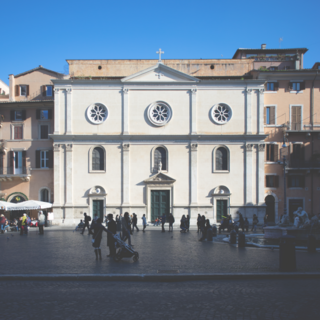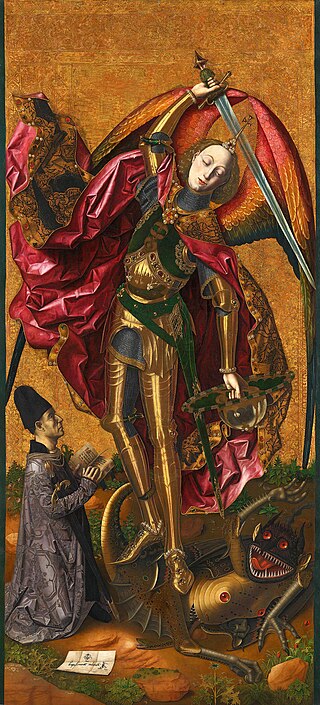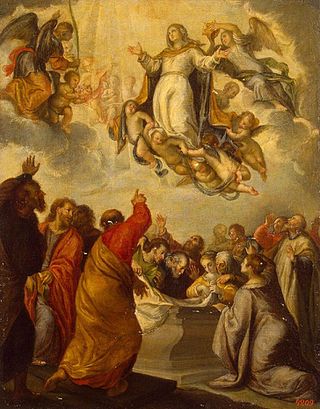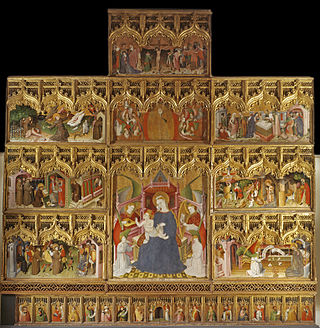
Jaume Serra (died after 1405) was a Catalan painter. Serra was influenced heavily by a Sienese style introduced by Ferrer Bassa. [1]

Jaume Serra (died after 1405) was a Catalan painter. Serra was influenced heavily by a Sienese style introduced by Ferrer Bassa. [1]
Serra was a member of a family of artists active in the Principality of Catalonia in the fourteenth century. His brothers Pere, Francesc and Joan were also painters of italogótico style. The Serra brothers are characterized by the painting of tiny, stylized, slanted eyes and small mouth figures. Jaume painted Madonna of Humility. He also collaborated with his brothers in the realization of the altarpiece of the Monastery of Santa María de Sigena, now in the Museu Nacional d'Art de Catalunya in Barcelona.
Two additional altarpieces are preserved in the Museum of Zaragoza. The Virgin from the Convent of the Holy Sepulchre (Zaragoza) and Martin de Alpartil or the Resurrection (with the portrait of the friar as a donor). The third altarpiece is from the Shrine of Our Lady of Tobed, in Zaragoza, whose execution is documented between 1356 and 1359. It is formed by a central table, the Virgin of Tobed, which are represented the nursing Virgin and Child with the future king of Castile Henry II of Castile as a donor, and its two doors, painted in tempera and altarpieces independent dedicated to Mary Magdalene and John the Baptist, whose stories are told in three successive records on the bench with various saints. The set was kept divided between the Museo del Prado in Madrid, which had since 1965 the two side tables, and Várez Fisa collection, until in 2013 the collection has been donated to the Madrid museum main table, so that the altar could be made whole again. [2] Jaume's altarpiece The Holy Spirit can be found in the Manresa cathedral.

Robert Campin, now usually identified with the Master of Flémalle, was a master painter who, along with Jan van Eyck, initiated the development of Early Netherlandish painting, a key development in the early Northern Renaissance.

Lorenzo Lotto was an Italian Renaissance painter, draughtsman, and illustrator, traditionally placed in the Venetian school, though much of his career was spent in other north Italian cities. He painted mainly altarpieces, religious subjects and portraits. He was active during the High Renaissance and the first half of the Mannerist period, but his work maintained a generally similar High Renaissance style throughout his career, although his nervous and eccentric posings and distortions represented a transitional stage to the Florentine and Roman Mannerists.

Paris Bordone was an Italian painter of the Venetian Renaissance who, despite training with Titian, maintained a strand of Mannerist complexity and provincial vigor.

Juan de Flandes was a Flemish painter active in Spain from 1496 to 1519. His actual name is unknown, although an inscription Juan Astrat on the back of one work suggests a name such as "Jan van der Straat". Jan Sallaert, who became a master in Ghent in 1480, has also been suggested. He worked in the Early Netherlandish style.

The Museu Nacional d'Art de Catalunya, abbreviated as MNAC, is a museum of Catalan visual art located in Barcelona, Catalonia, Spain. Situated on Montjuïc hill at the end of Avinguda de la Reina Maria Cristina, near Pl Espanya, the museum is especially notable for its outstanding collection of romanesque church paintings, and for Catalan art and design from the late 19th and early 20th centuries, including modernisme and noucentisme. The museum is housed in the Palau Nacional, a huge, Italian-style building dating to 1929. The Palau Nacional, which has housed the Museu d'Art de Catalunya since 1934, was declared a national museum in 1990 under the Museums Law passed by the Catalan Government. That same year, a thorough renovation process was launched to refurbish the site, based on plans drawn up by the architects Gae Aulenti and Enric Steegmann, who were later joined in the undertaking by Josep Benedito. The Oval Hall was reopened for the 1992 Summer Olympic Games, and the various collections were installed and opened over the period from 1995 to 2004. The museum was officially inaugurated on 16 December 2004. It is one of the largest museums in Spain.

Nostra Signora del Sacro Cuore is a Catholic church dedicated to the Virgin Mary located in Rome's Piazza Navona.

Bartolomé Bermejo was a Spanish painter who adopted Flemish painting techniques and conventions. Born in Cordoba, he is known for his work in the Crown of Aragon, including the Principality of Catalonia and the Kingdom of Valencia. His real name was Bartolomé de Cárdenas: the name Bermejo, which means auburn in Spanish, possibly relates to his hair colour. Bermejo may relate also to his surname, Cárdenas; Cardeno means purplish. He signs himself sometimes as "Bartolomeus Rubeus" meaning possibly "Bartholomew the Redhead".

Friar Nicolás Borrás (1530–1610) was a Spanish Renaissance Catholic monk and painter, active in Valencia.

Tomás de Yepes or Hiepes was a Spanish painter in the Kingdom of Valencia. An artist of the Baroque movement, he worked as a painter of still life and bodegón—still life paintings depicting pantry items. He made paintings both for clients and public events. Although his activity started in the second decade of the 17th century, most of the works attributed to him come after 1642. He continued to paint until the year of his death.

Fernando Gallego was a Castillan painter, and his art is generally regarded as Hispano-Flemish in style. Gallego was likely born in Salamanca, Spain, and worked throughout Castile and Extremadura, most notably in Ciudad Rodrigo, Plasencia, Toro, and Zamora.

Francisco Camilo was a Spanish painter, the son of an Italian immigrant who had settled in Madrid. When his father died, his mother remarried, and Camilo became the stepson of the painter Pedro de las Cuevas.

Jaume Huguet was a Catalan painter.

Pere Serra was a painter in Gothic-Italian style, who was active in Catalonia in 1357–1406.

The Virgin of the Angels is a painting by Pere Serra conserved at the National Art Museum of Catalonia.

Nicolás Francés was a Spanish painter and miniaturist.

Martín Bernat was a Spanish Gothic style painter, active in Zaragoza, where he had a long collaboration with Bartolomé Bermejo. His dates of birth and death are not known.

Jerónimo Vicente Vallejo Cósida was a Spanish Renaissance painter, sculptor, goldsmith and architect.

Jaume Morera i Galícia was a Catalan landscape painter.
The Doña María de Aragón Altarpiece was an altarpiece painted between 1596 and 1599 by El Greco for the chapel of the Colegio de la Encarnación in Madrid. The college was secularised during Goya's lifetime and the altarpiece was dismantled. There has been much speculation over which paintings belonged to the work. The consensus view is that it consisted of six large canvases and a seventh, now lost. Five of those six canvases are now in the Prado and the sixth is in the National Museum of Art of Romania in Bucharest.

Diego de la Cruz was a Spanish painter who may have been of Flemish origin. He was active in Burgos and the neighboring region.